Massachusetts is known for housing some of the most popular colleges and universities in the world.
However, the Bay State is also known for being home to more than 505 recorded species of birds, according to the Massachusetts Avian Records Committee (MARC).
This is a pretty impressive number for a relatively small-sized state, which makes Massachusetts a very decent spot for bird-watching enthusiasts from all over the country!
To help you explore the beautiful variety of birds in the states, we’ve compiled this list of the most impressive birds in Massachusetts, arranged by their color.
So without further ado, let’s dive in and find out more about each one of them!
Red Birds in Massachusetts
House Finch

- Scientific Name: Haemorhous mexicanus
- Length: 4.9 to 6.1 in
- Weight: 0.6 to 0.9 oz
- Wingspan: 8.1 to 10.5 in
Additional Information:
Starting off with one of the most common birds that you can find in Massachusetts.
You can easily attract house finches to your backyard bird feeder, as they feed on all kinds of seeds and small berries.
House finches are one of the birds that are heavily affected by the quality of diet they’re having, especially the males.
A well-fed and healthy male will rock an attractive rosy red color, especially on their face and upper breast. Females, on the other hand, have brown bodies with streaks running all over them.
Red-Winged Blackbird
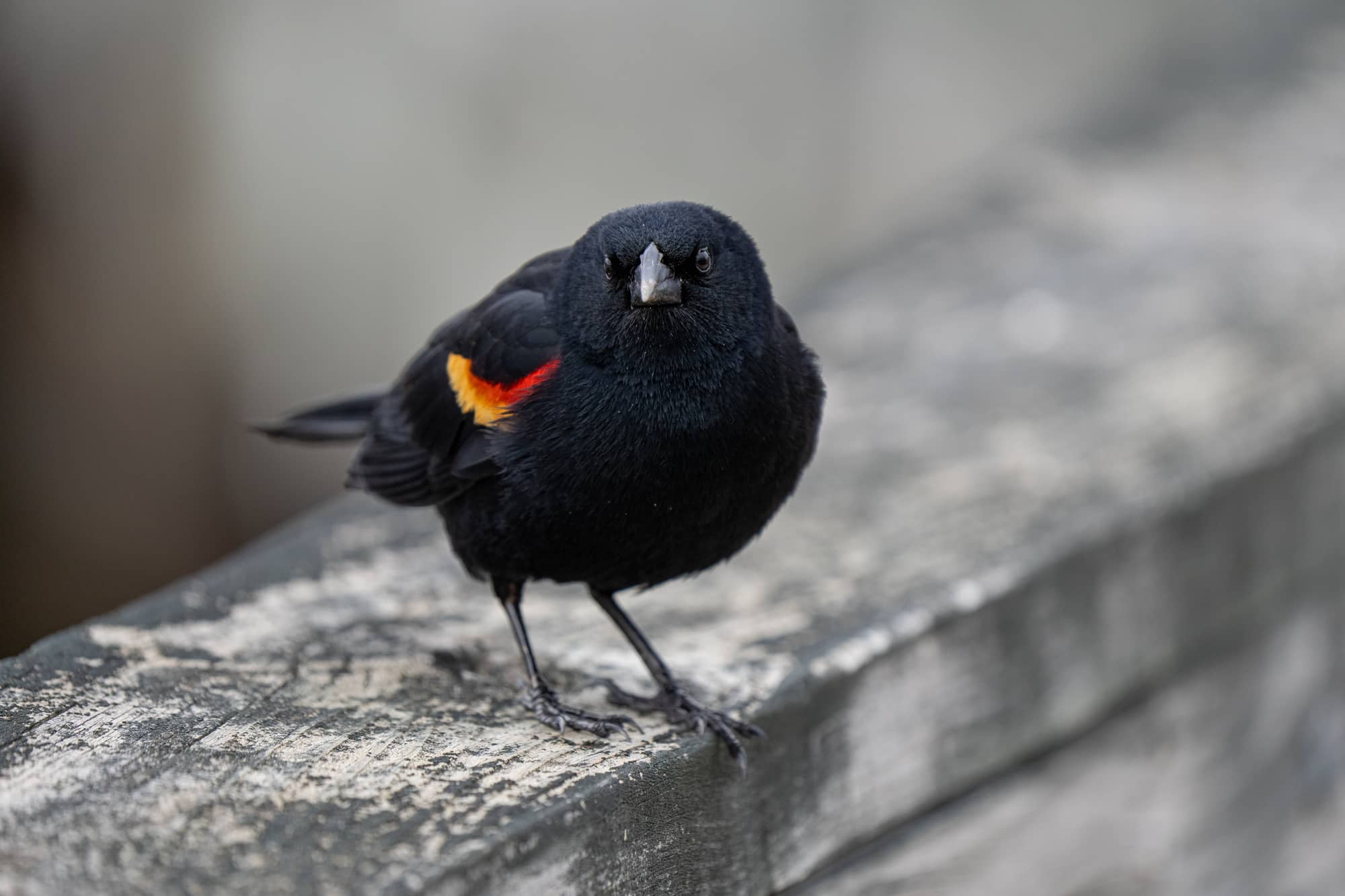
- Scientific name: Agelaius phoeniceus
- Length: 6.7 to 9.1 in
- Weight: 1.1 to 2.7 oz
- Wingspan: 12.2 to 15.8 in
Additional Information:
Similar to the common blackbird, the males of the species have all-black plumage. However, they’re characterized by the bright red and yellow patch on the top of their wings.
Females look quite different, as they’re typically brown with a yellowish bill and streaks covering their back and wings.
Red-Winged Blackbirds are quite common all over the state, but they’re heavily concentrated in wetlands, marshes, and other areas where a supply of water can be found.
Keep in mind that they’re extremely territorial and males may attack intruders in their area.
Northern Cardinal

- Scientific Name: Cardinalis cardinalis
- Length: 8.3 to 9.1 in
- Weight: 1.5 to 1.7 oz
- Wingspan: 8.9 to 12.2 in
Additional Information:
Northern Cardinals are one of the most impressive birds that you can find hovering around your bird feeder. The males have a stunningly attractive red plumage that will immediately attract your attention.
Females of the species have paler plumage with a yellowish-brown body and an orange crest, tail, and wings.
Both sexes have a thick orange-red bill and a black mask that covers their faces and throats. They’re pretty loud with a lovely singing tone, but the males often fight each other for territory
Summer Tanager
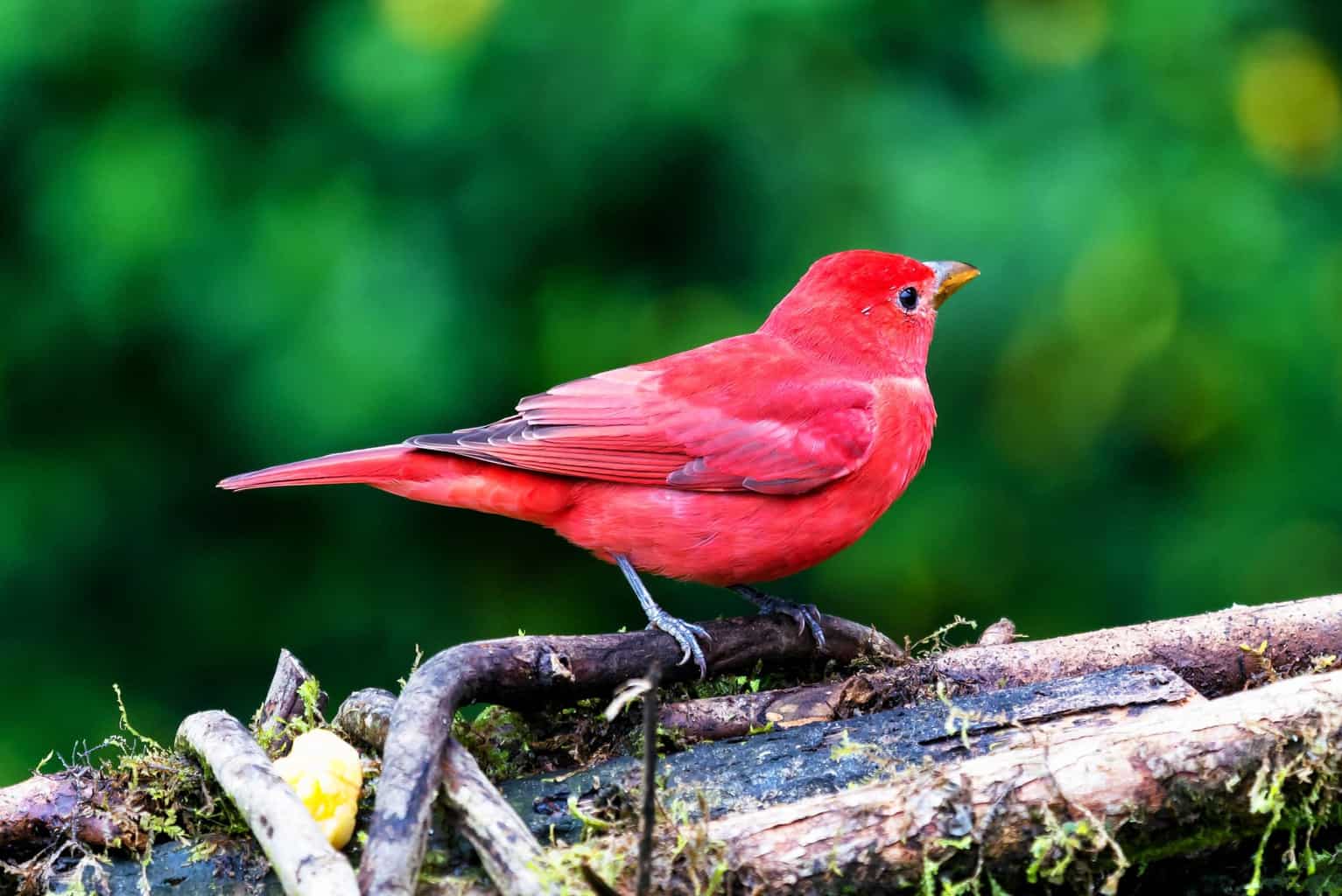
- Scientific Name: Piranga rubra
- Length: 6.1 to 6.9 in
- Weight: 0.8 to 1.1 oz
- Wingspan: 11.1 to 11.9 in
Additional Information:
Summer Tanagers are lovely songbirds that are as small as house sparrows. They belong to the family of cardinals, as they have the same body characteristics, plumage patterns, and feeding.
The males have quite a lovely orange-red color that covers all of their bodies, which tends to get more vibrant as it goes toward their heads. Females have a pale brownish color with a fairly slim body.
These birds are regulars at bird feeders because they’re highly adapted to living in the trees of city parks and urban neighborhoods. They feed on everything from suet and fruits to food remains.
Downy Woodpecker
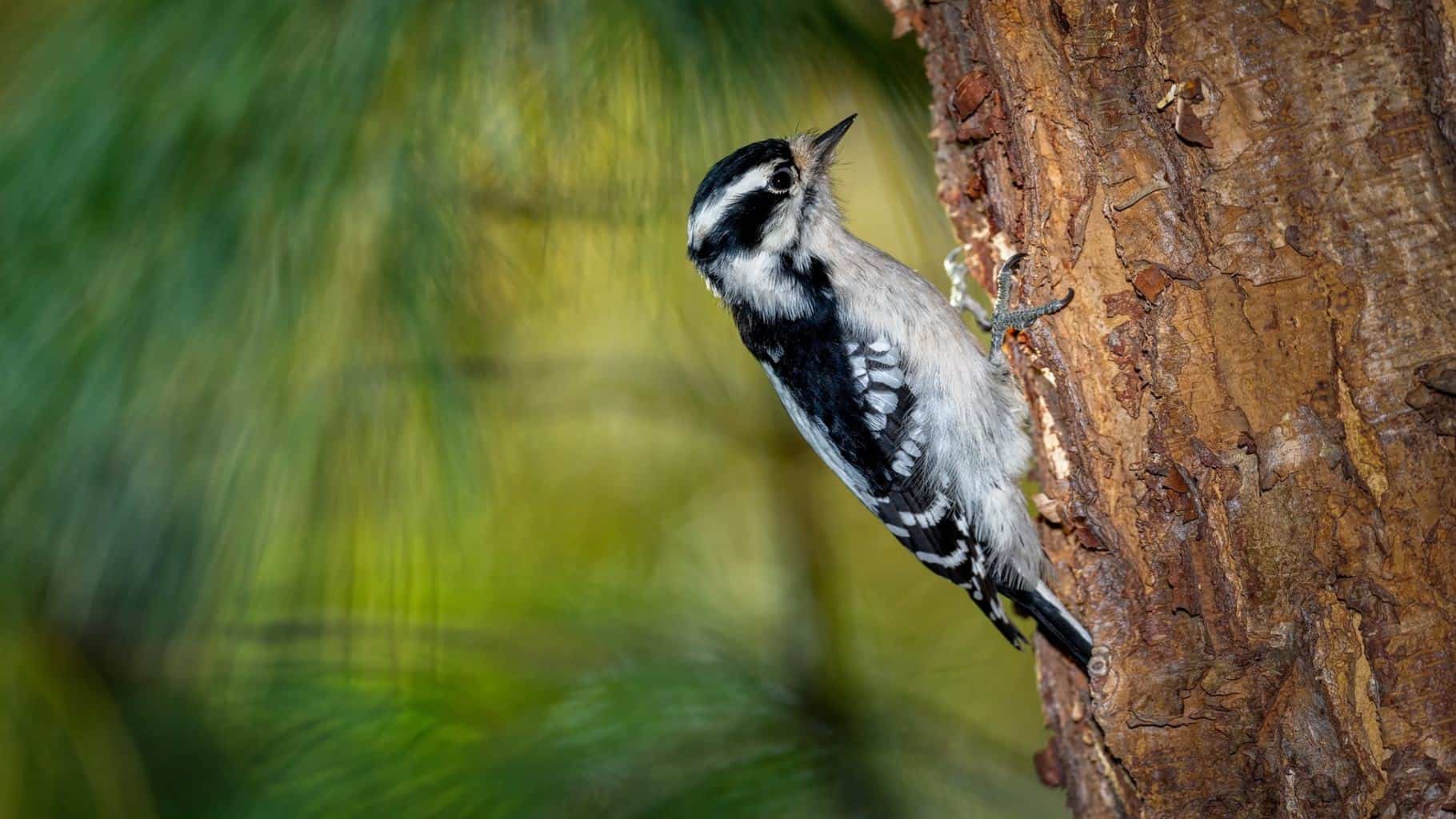
- Scientific Name: Dryobates pubescens
- Length: 5.5 to 7.1 In
- Weight: 0.7 to 1.1 oz
- Wingspan: 9.8 to 12.2 In
Additional information:
There’s a wide variety of woodpeckers in the state of Massachusetts. However, if you encounter a woodpecker, they’re more likely to be a Downy Woodpecker than any other species.
Downy Woodpeckers may not be the most colorful woodpecker, but the males have a characteristic red nape that sets them apart from other species. Females have the same white and black body but they lack the red patch.
The Downy Woodpecker is well adapted to living around residential areas and will often land in your yard while foraging. They eat a variety of fruits, and seeds, as well as general food leftovers.
Red-Bellied Woodpecker

- Scientific Name: Melanerpes carolinus
- Length: 9.2 to 10.3 in
- Weight: 2.2 to 3.2 oz
- Wingspan: 15.7 to 17.8 in
Additional Information:
The Red-bellied Woodpecker is quite common in the state. Although they aren’t as common as the Downy Woodpecker, they have some unique features that make them easy to identify.
For example, they have a black and white barred back with a brilliant red patch at the back of their head.
Both males and females share these features, except males have a long red patch that extends all the way to the beaks. These birds are also well adapted to residential areas, so you can spot them in your backyards.
However, you can find some of them in forests and near small ponds, as they feed on small fish too.
Blue Birds in Massachusetts
Blue Jay

- Scientific Name: Cyanocitta cristata
- Length: 8.6 to 11.8 in
- Weight: 2.5 to 3.5 oz
- Wingspan: 13.3 to 16.9 in
Additional Information:
There’s a huge variety of blue-colored birds in the state of Massachusetts. However, the Blue Jay is easily one of the most common.
Despite having an astonishing blue and cyan color, they don’t have any blue pigments in their feathers.
Instead, they have a unique feather structure that reflects blue color only, giving them a unique look that you’re going to love, despite being remarkably loud birds.
These birds enjoy a wide range of food, including seeds, insects, and even nuts. In fact, they’re quite intelligent birds and one of the few species that are capable of cracking a nut open!
Eastern Bluebird
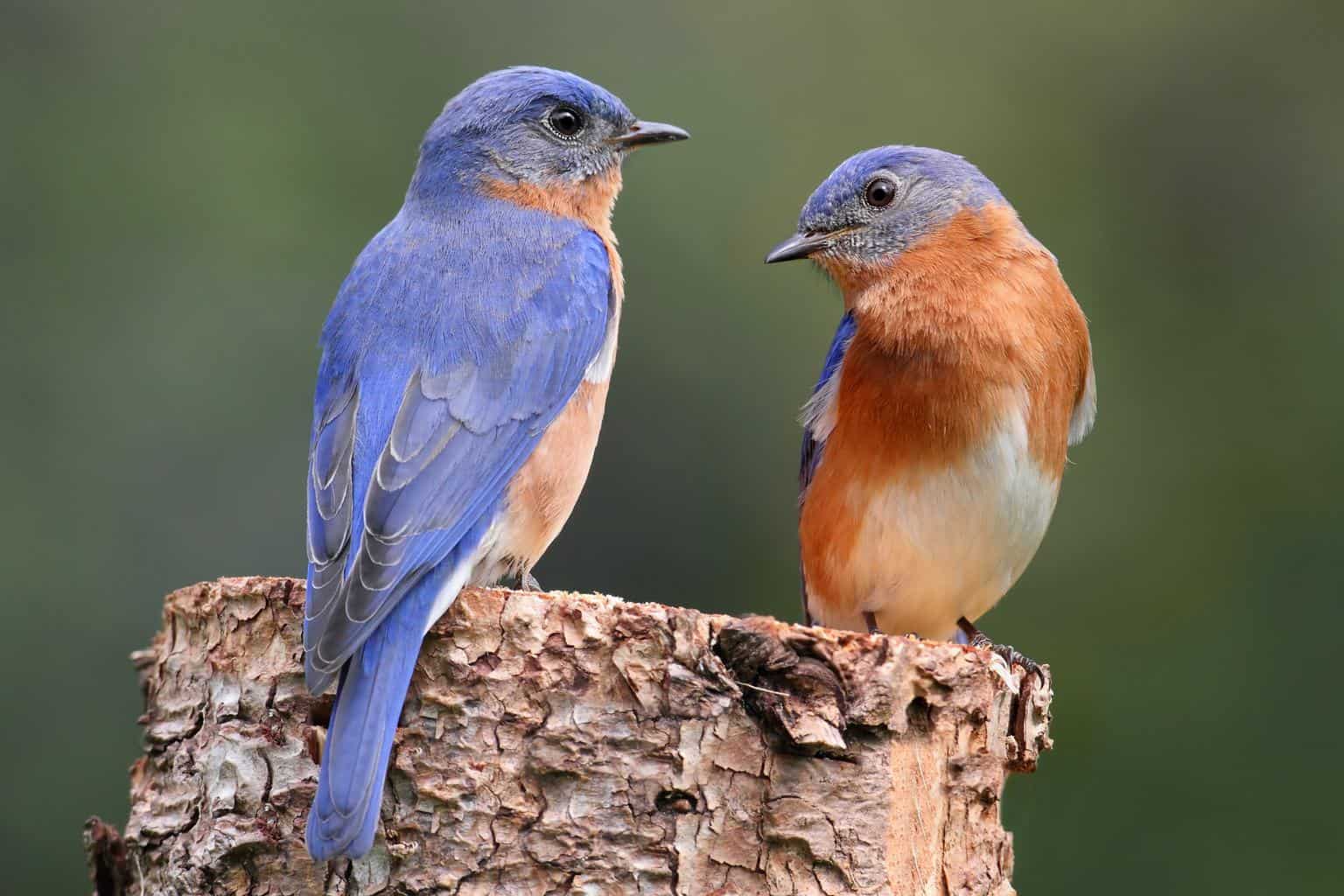
- Scientific Name: Sialia sialis
- Length: 6.3 to 8.3 in
- Weight: 0.9 to 1.2 oz
- Wingspan: 9.8 to 12.6 in
Additional Information:
Eastern Bluebirds are decently common in Massachusetts, and they’re loved by everyone for their lovely look and relatively soft tones.
Both males and females have the same color patterns, with blue feathers covering the backs, wings, and heat, while the rest of the body is bronze and white. However, the blue color is rather paler in females.
Bluebirds like to perch on telephone wires and fly above open fields. However, if you add lucrative food to your bird feeders, such as mealworms, insects, and berries, they can stop by your backyard!
Common Grackle
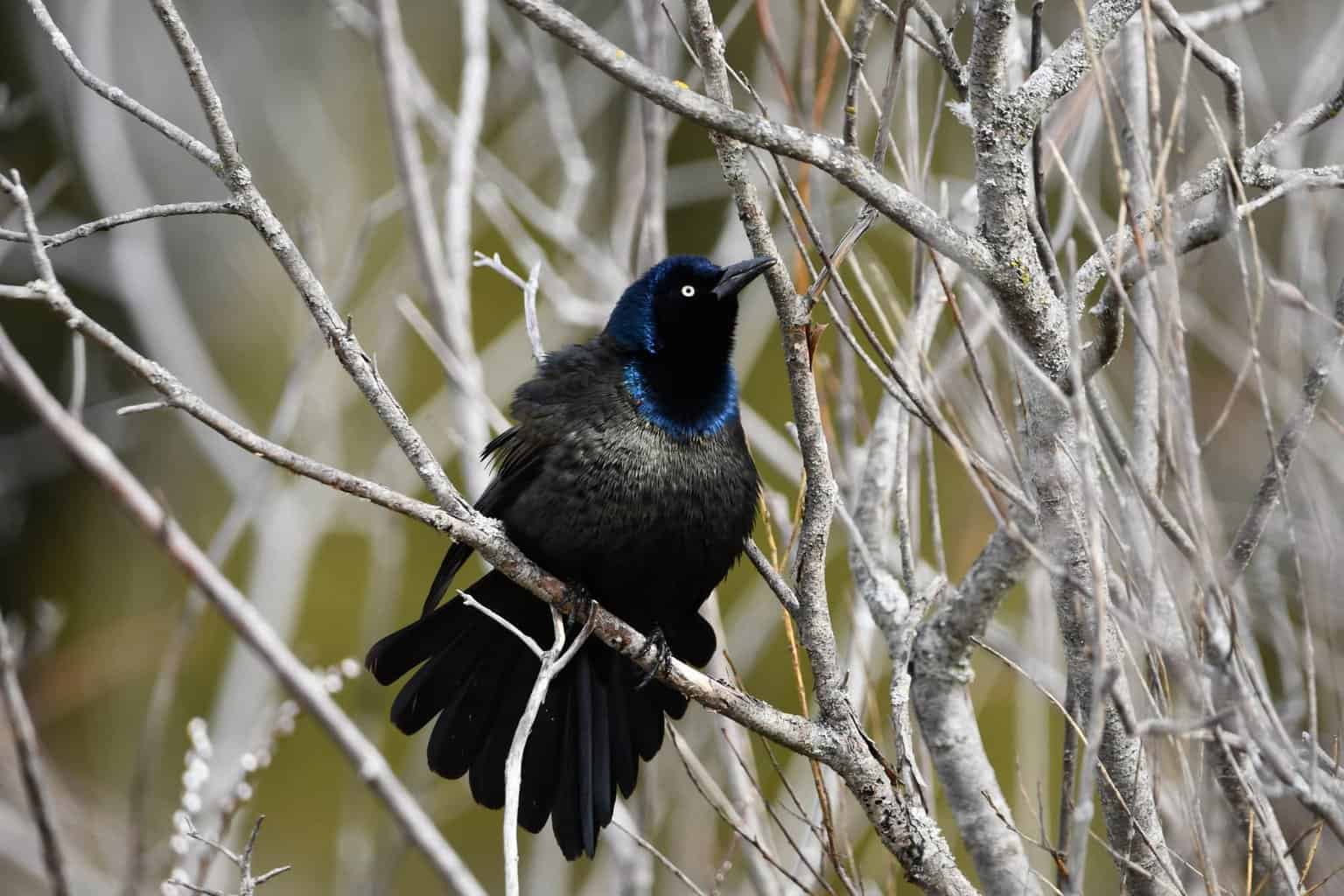
- Scientific name: Quiscalus quiscula
- Length: 11.0 to 13.4 in
- Weight: 2.6 to 5.0 oz
- Wingspan: 14.2 to 18.1 in
Additional Information:
The Common Grackle is a relatively large and lanky bird that belongs to the family of blackbirds. However, it has a unique iridescent purplish-blue and turquoise head with a glossy brown to bronze plumage across the body.
The females have similar color patterns but with less glossiness. It’s quite easy to spot a Common Grackle because it’s a social bird that likes to live in large flocks. You can find them around agricultural fields that grow their favorite foods.
This extremely resourceful bird has an ample appetite and would eat just about anything from fruits, seeds, insects, small amphibians and reptiles, mice, smaller birds, and more!
Indigo Bunting

- Scientific Name: Passerina cyanea
- Length: 4.5 to 5.9 in
- Weight: 0.4 to 0.6 oz
- Wingspan: 7.0 to 9.0 in
Additional Information:
The Indigo Bunting is a relatively small and stocky bird that is quite easy to identify due to its unique looks and behaviors, and they belong to the singing cardinal family.
The male of this species is one of the smallest blue-colored songbirds out there. On the other hand, the females are mostly brown.
The bird has a lovely singing tone and they typically exist in Massachusetts throughout the Summer months, as they migrate to Central and South America in the Winter.
Blue Grosbeak

- Scientific name: Passerina caerulea
- Length: 5.9 to 6.3 in
- Weight: 0.9 to 1.1 oz
- Wingspan: 10.8 to 11.1 in
Additional Information:
The Blue Grosbeak is a relatively small and stocky songbird with a significantly large beak-to-head ratio. The bird is slightly larger in size than Indigo Buntings but smaller than a Barn Swallow.
The males have a deep blue plumage all across their bodies, except for a few buff streaks and patches on the wing.
The bird is a migratory one that generally spends most of the year in the southern states, but has been regularly reported within Massachusetts borders.
Barn Swallow

- Scientific Name: Hirundo rustica
- Length: 6.7 to 7.5 in
- Weight: 0.56 to 0.78 oz
- Wingspan: 12.6 to 13.6 in
Additional Information:
The Barn Swallow is one of the most common swallow passerines in the world and is a frequent backyard visitor during the warm summer months, especially around meadows and open fields.
You can easily characterize the Barn Swallow due to its steely blue plumage that covers the top portion of the body, including the back, tail, head, and wings. The bird also has a forked tail that makes it recognizable while flying.
When they’re not foraging for insects, such as ants and beetles, they like to perch on telephone wires to overlook their territory.
Green Birds in Massachusetts
Ruby-Throated Hummingbird
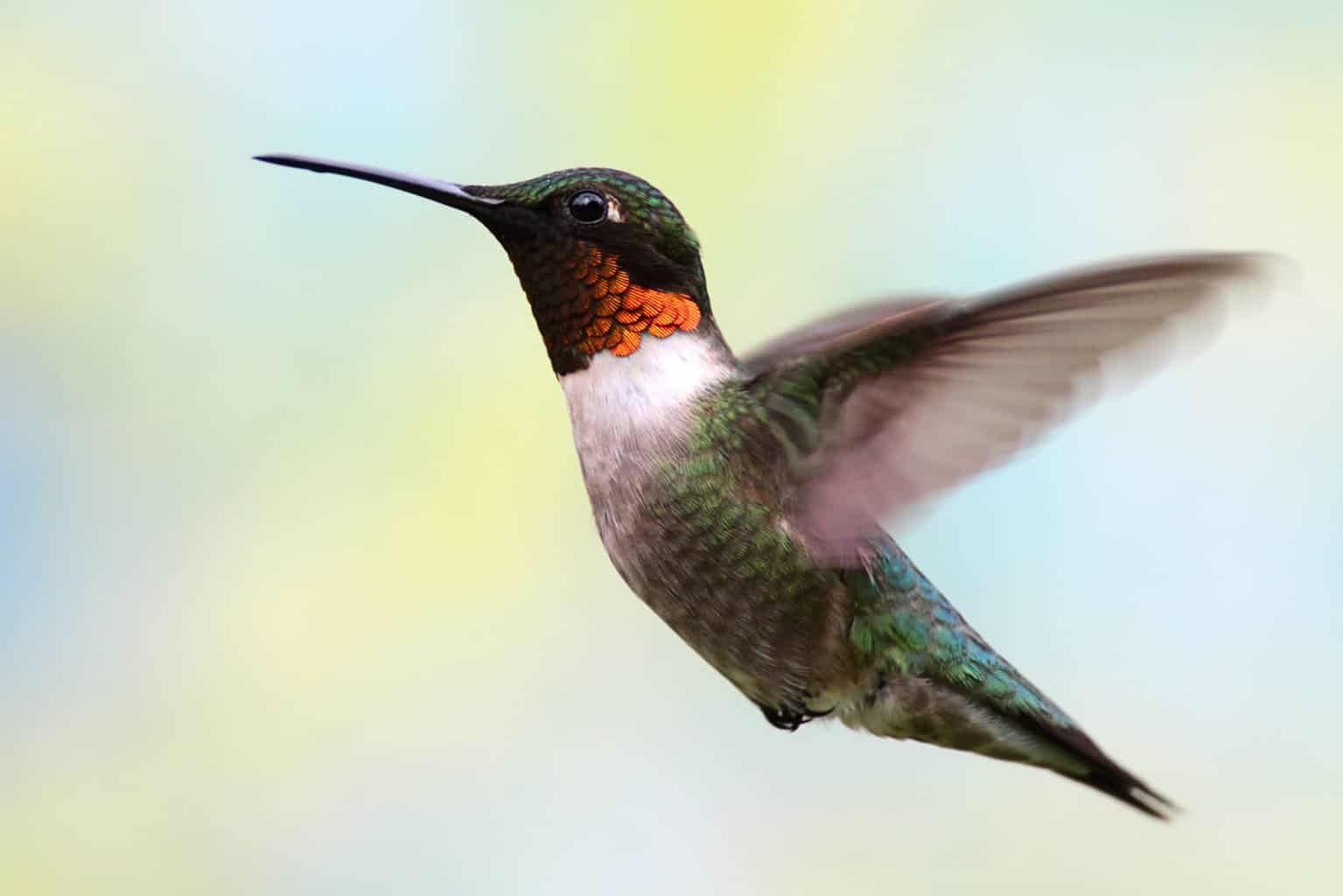
- Scientific Name: Archilochus colubris
- Length: 2.8 to 3.5 in
- Weight: 0.1 to 0.2 oz
- Wingspan: 3.1 to 4.3 in
Additional Information:
The Ruby-throated Hummingbird is the only type of hummingbird that typically nests in Massachusetts throughout the summer
The males and females of the species are extremely different. Males typically have brilliant ruby red feathers all over their throats and the top of the chest with a noticeable black mask. The rest of the body, especially the head and the back is olive green.
Females, on the other hand, have pale green streaks over their throats with the rest of their body ranging between washed green and buff color.
Green-Tailed Towhee
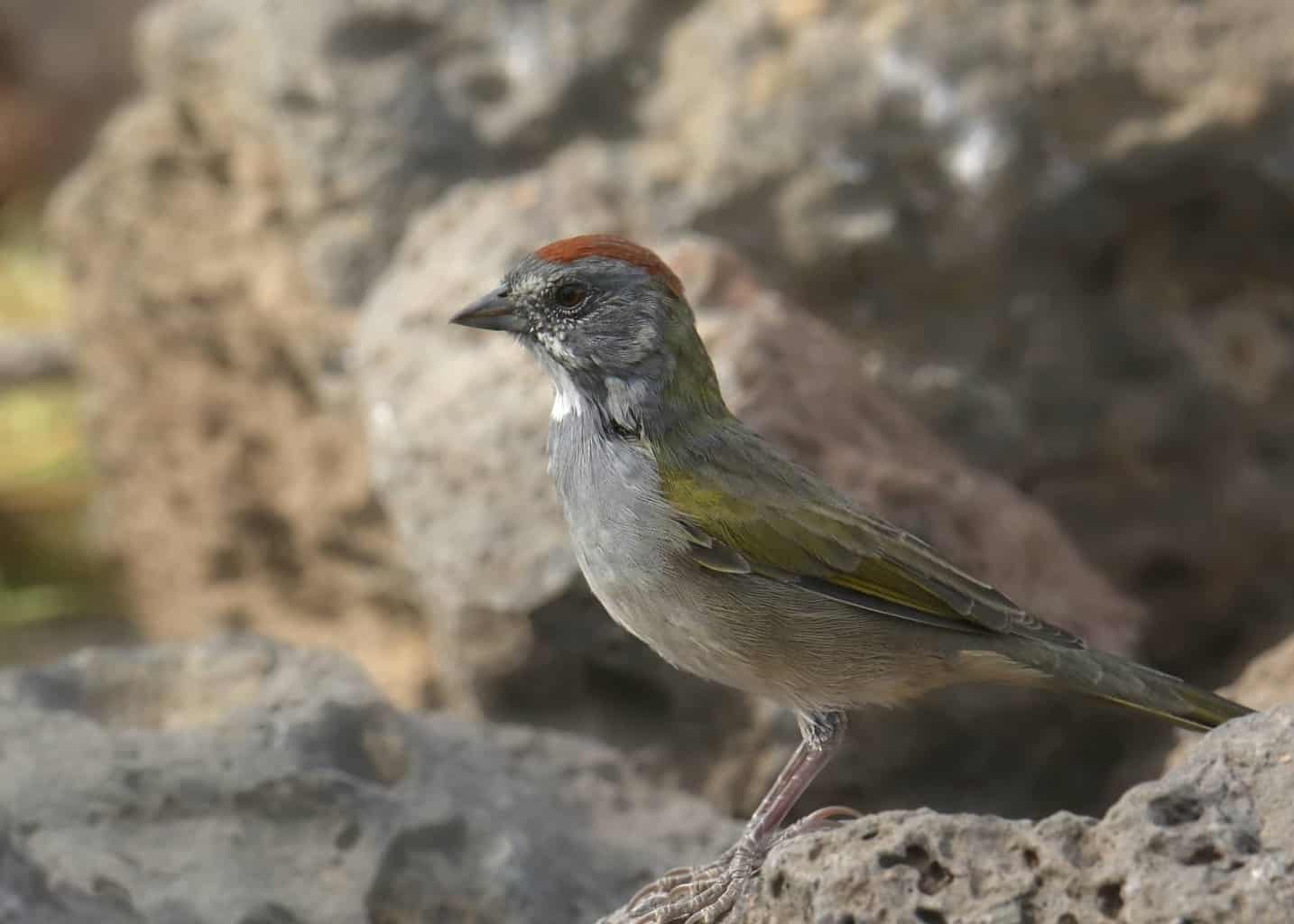
- Scientific name: Pipilo chlorurus
- Length: 7.2 to 7.3 in
- Weight: 0.8 to 1.4 oz
- Wingspan: 10.0 to 10.8 in
Additional Information:
The Green-tailed Towhee is one of the most uniquely colored birds out there. They rock deep olive to yellowish-green streaks on their wings and tails. They also have a remarkable bronze crown with a white throat and grey underparts.
The bird is quite rare in Massachusetts, as it’s more common in the east, where its natural habitat of shrubby mountains is found. However, there are reports about sightings of the bird in Essex county.
Green-Winged Teal
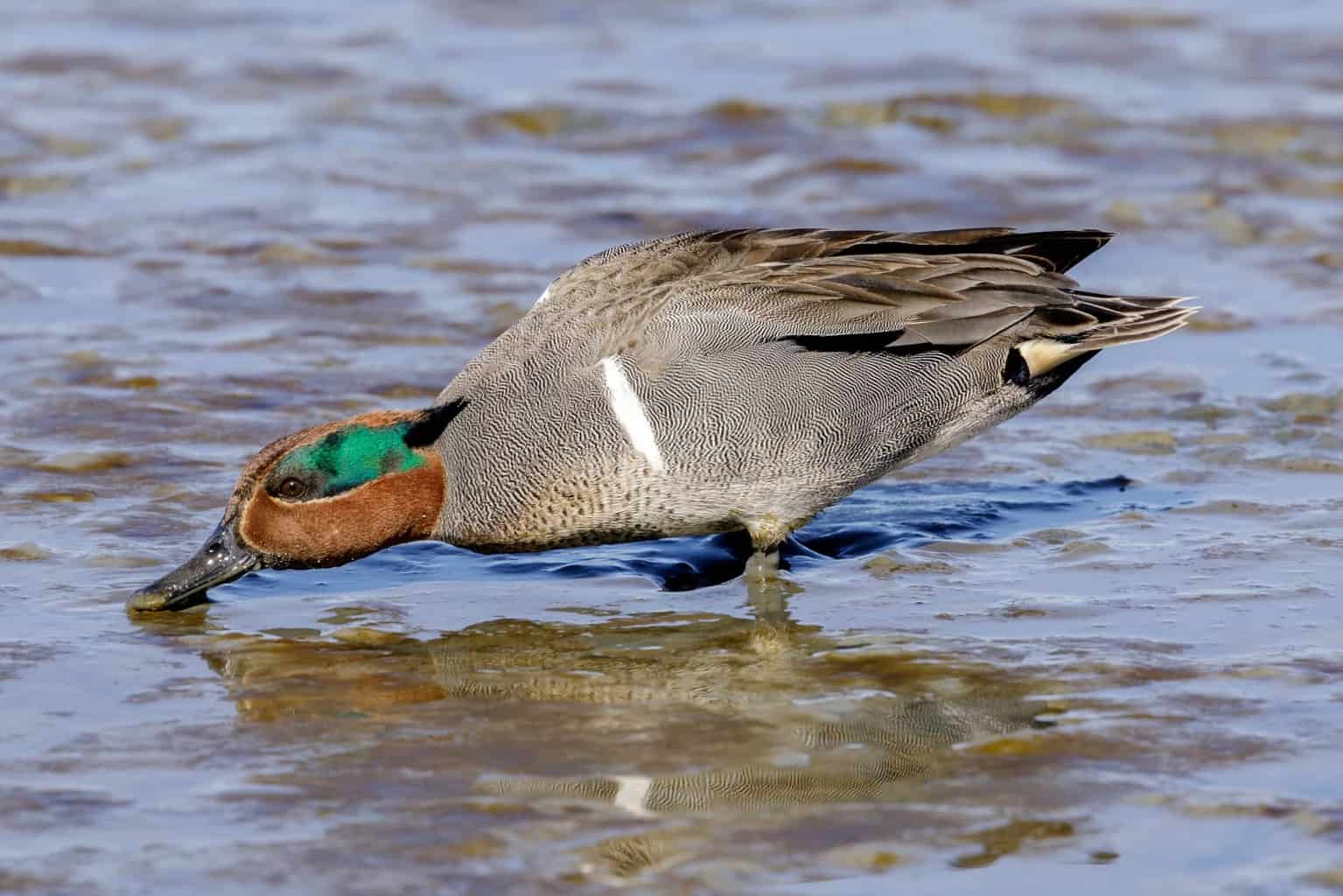
- Scientific name: Anas carolinensis
- Length: 12.2 to 15.3 in
- Weight: 4.9 to 17.6 oz
- Wingspan: 20.5 to 23.2 in
Additional Information:
The Green-winged Teal is one of the smallest duck species in the Northeast region and the smallest of all dabbling ducks.
This pigeon-sized male duck has a brownish body with a noticeable green patch that extends from the eyes all the way to the back of the head.
The chest of the duck has noticeable freckling with dark brown spots along with a white vertical band that extends along the side to separate between the teal’s back and head.
Orange Birds in Massachusetts
American Robin

- Scientific Name: Turdus migratorius
- Length: 9.0 to 11.0 in
- Weight: 2.3 to 2.8 oz
- Wingspan: 14.7 to 16.5 in
Additional Information:
American Robins are one of the most beautiful and widespread backyard birds in America. The thrush is known for its rusty orange coloring on the bird’s breast and underparts. The robin’s head and back have a dark grey to black color.
The female birds also share these features but are rather paler. They also lack the white patches that characterize the males.
The bird is known for laying beautiful and small sky-blue eggs and they have a mild singing tone that you can easily hear as they hang around bird feeders.
Baltimore Oriole
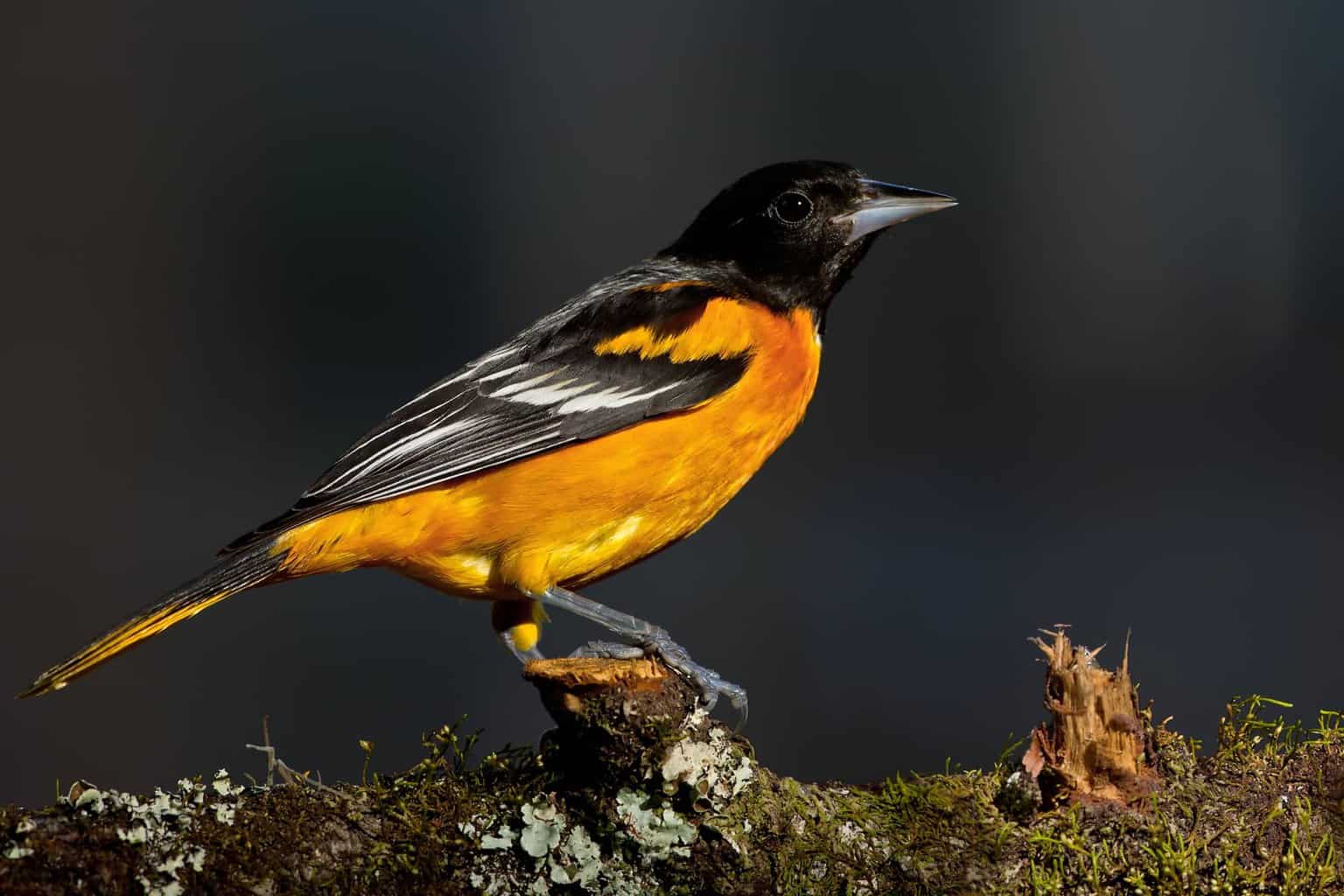
- Scientific Name: Icterus galbula
- Length: 5.8 to 7.8 in
- Weight: 2.3 to 3.5 oz
- Wingspan: 3.5 to 4.7 in
Additional Information:
The Baltimore Orioles are one of the most beautiful birds that you can find from spring to fall in the state of Massachusetts.
The bird has a unique and vibrant orange color that covers the wings, rump, and underparts, especially the males.
Females have a wider range of orange that extends from flaming orange, similar to the males, all the way to pale yellowish plumage.
These stunning birds are usually found at the top of deciduous trees in the forests but can also be found foraging around their regions.
Yellow Birds in Massachusetts
American Goldfinch
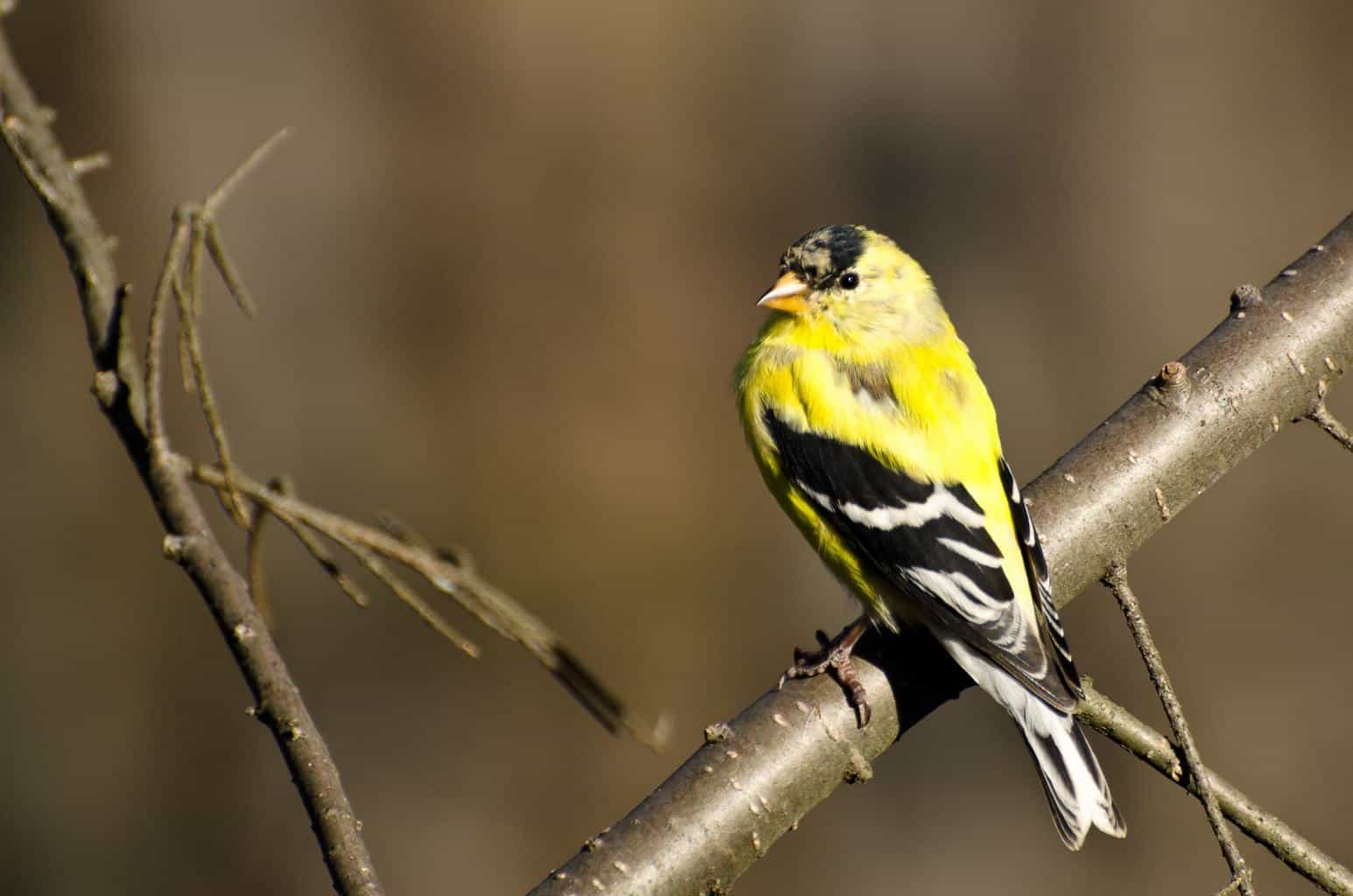
- Scientific Name: Spinus tristis
- Length: 4.3 to 5.5 in
- Weight: 0.39 to 0.71 oz
- Wingspan: 7.5 to 8.7 in
Additional Information:
Similar to the American Robin, the American Goldfinch is also an extremely common resident of bird feeders and is quite easy to identify, even if you’re a beginner.
In summer, the male American Goldfinch has a vibrant golden-yellow plumage that covers its body entirely except for its black wings and head patches. Females have similar patterns but with duller colors and no head patches.
In winter, both of them replace the yellow coats with a brownish one that can also be slightly olive.
American Yellow Warbler
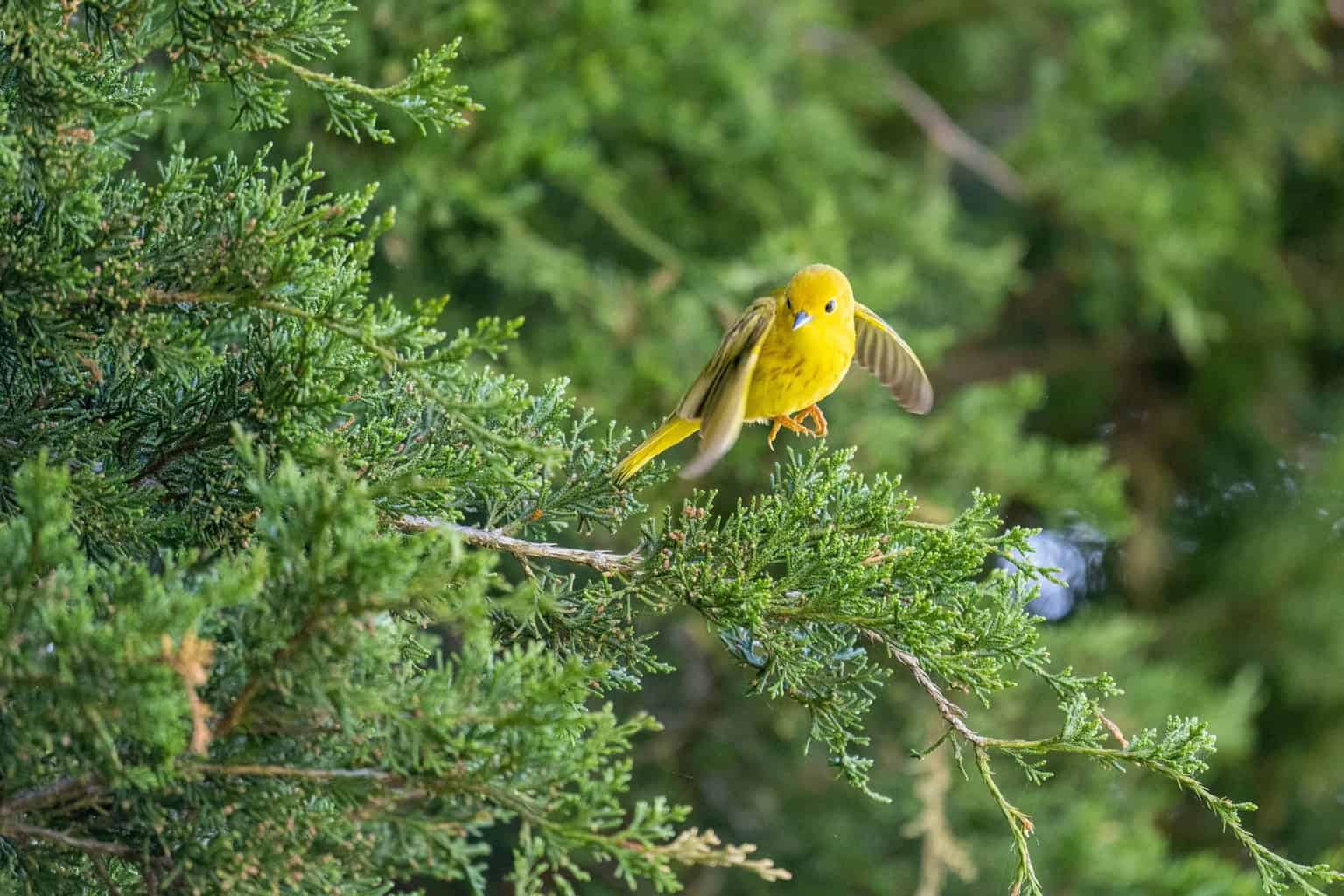
- Scientific Name: Setophaga petechia
- Length: 4.7 to 5.1 in
- Weight: 0.3 to 0.4 oz
- Wingspan: 6.3 to 7.9 in
Additional Information:
The Yellow Warbler is one of the most common warblers in the New England region and you can identify the bird from its bright yellow plumage that has a noticeable olive green wash, especially at the back.
The birds like to live perched on high trees that overlook lakes and small bodies of water, so you can find them in the forests around the state.
Other Birds in Massachusetts
Black-Capped Chickadee

- Scientific name: Poecile atricapillus
- Length: 4.7 to 5.9 in
- Weight: 0.3 to 0.5 oz
- Wingspan: 6.3 to 8.3 in
Additional Information:
The Black-capped Chickadee is found all across the Northeast. However, Massachusetts has a special love for the bird that they’ve named it the state’s bird!
The small-sized bird has a noticeably large head and short neck when compared to its small spherical body.
The bird also has a long and thin tail and a thick short bill that helps them eat a wide variety of foods, including insects, seeds, fruits, and even carrion!
The bird has a puffy plumage with deep black color covering its bib and cap, hence the name. The rest of the body is white and soft gray, covering its wings, cheeks, and back.
White-Breasted Nuthatch
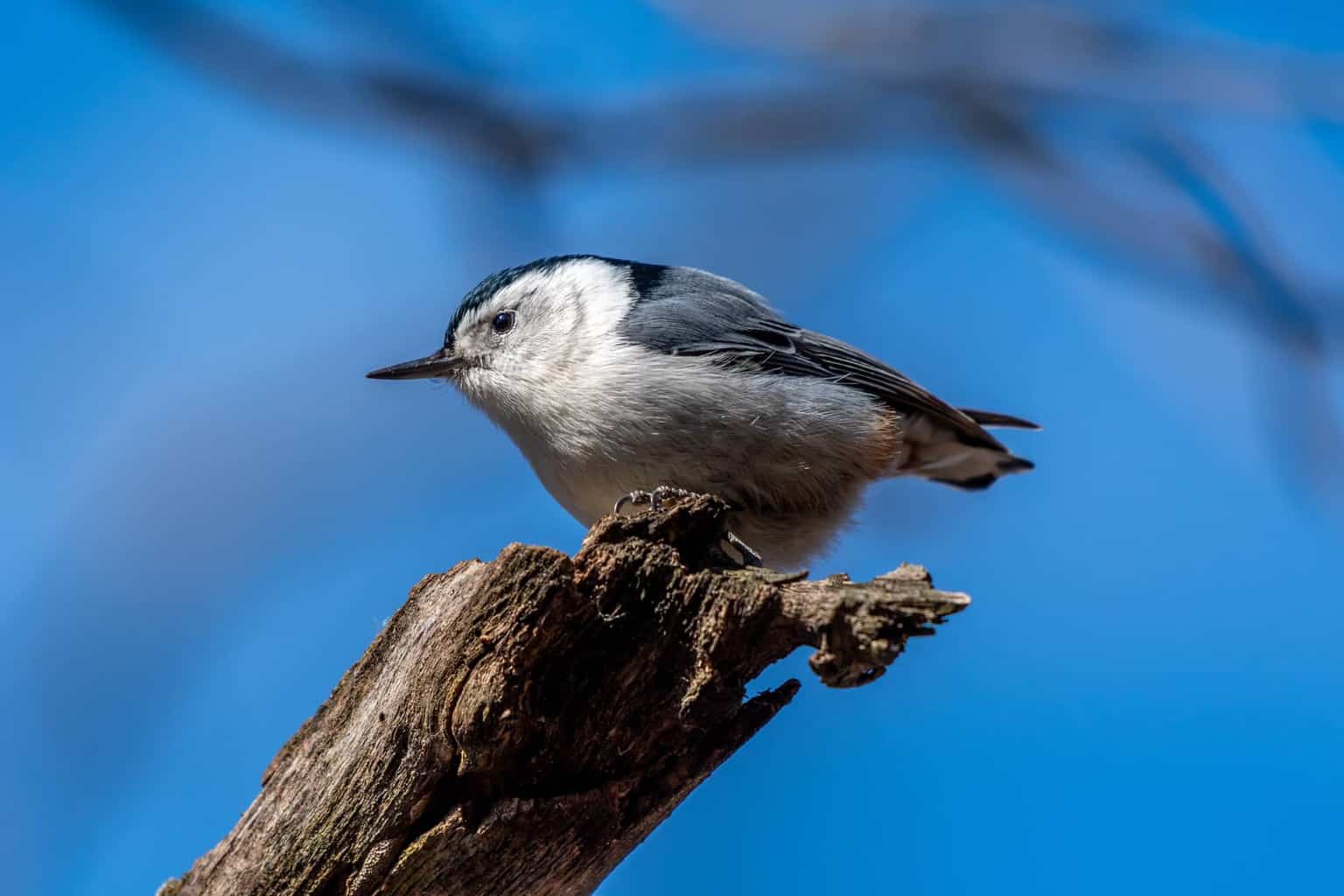
- Scientific name: Sitta carolinensis
- Length: 5.1 to 5.5 in
- Weight: 0.6 to 1.1 oz
- Wingspan: 7.9 to 10.6 in
Additional Information:
The White-breasted Nuthatch is one of the few common backyard birds that you can find all year round in the New England region.
These popular birds have characteristic white plumage on the breast, face, and underparts. The rest of their body is bluish-gray, including the back of the head, wings, and tails.
Speaking of tails, they are noticeably long and pointy, which can help you identify them while they’re flying above deciduous forests.
Mourning Dove

- Scientific Name: Zenaida macroura
- Length: 11.8 to 12.2 In
- Weight: 4.3 to 6.4 oz
- Wingspan: 17.3 to 18.2 In
Additional Information:
Mourning Doves are quite common in Massachusetts. They’re known for their pale brown to buff plumage that covers their entire body.
However, the most characteristic features of the dove are the blue ring around their eyes as well as the black spots on their wings.
These colors make them difficult to identify from afar, especially when they match the environment around them to hide from predators.
Luckily, the Mourning Dove is well adapted to residential areas and will land near your bird feeder to look for food.
Since they like to feed on the ground, make sure that you spread some seeds and millet below the bird feeder for them.
European Starling

- Scientific name: Sturnus vulgaris
- Length: 7.9 to 9.1 in
- Weight: 2.1 to 3.4 oz
- Wingspan: 12.2 to 15.8 in
Additional Information:
As the name suggests, these birds aren’t native to Massachusetts. However, the resilient bird managed to invade the entire continent of North America after they were brought from Europe in the late 19th century.
This slender bird is pretty common all over the state and they have a unique iridescent black plumage that shines with hues of purple and green when you observe them from specific angles.
Females of the species don’t have this iridescent plumage but they still have nice heavily spotted black plumage with brown patches on the back and wings.
Males typically change their feather coats and replace them with dull ones in the winter.
Rock Dove
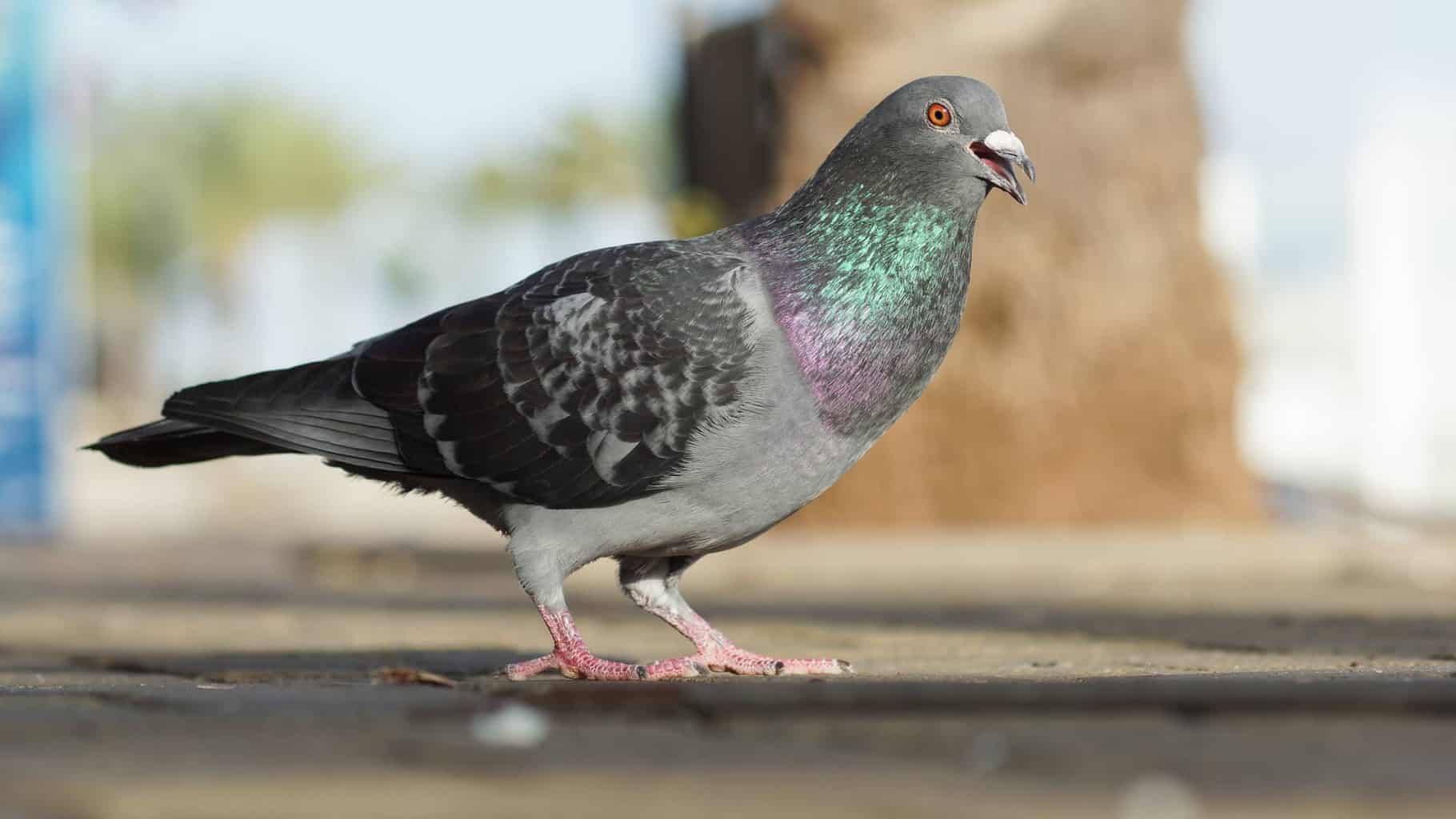
- Scientific name: Columba livia
- Length: 11.8 to 14.2 in
- Weight: 9.3 to 13.4 oz
- Wingspan: 19.7 to 26.4 in
Additional Information:
Also known as the Rock Pigeon, the tubby doves are slightly plumper than Mourning Doves and are pretty common in the Northeast region.
The Rock Dove varies in color depending on nutrition and seasons. However, they typically have a bluish-gray coat with characteristic iridescent throat plumage that shows tints of green and purple.
Although they’re well adapted to towns and cities, you can also find them hovering around agricultural fields, farmlands, and rocky cliffs, which is how they got their name.
Wrap Up
This concludes the list of the most impressive and colorful birds that you can find in Massachusetts. As you can see, the state is full of birds with a wide range of colors, habitats, and behaviors for bird watchers to enjoy.
So, next time you’re in the state, make sure that you bring binoculars along to make the most of these beautiful creatures!

